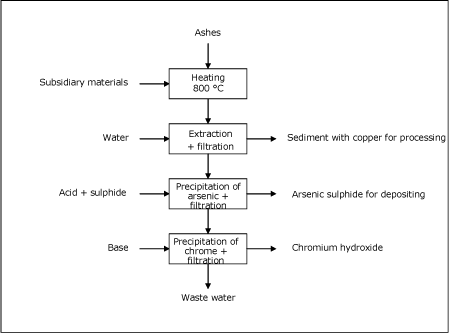Oparbejdning af aske fra forgasning af CCA-imprægneret træ
Summary
The purpose of the project was to develop a method and examine the costs in connection with processing of copper, chromium and arsenic in the ashes from the gasification of CCA-pressure-treated wood.
According to the waste strategy of the government in Denmark for 2005-2008, the quantity of CCA-pressure-treated wood for disposal is expected to rise to approximately 100,000 tonnes annually in 2010. Kommunekemi a/s has developed a method for gasification of CCA-pressure-treated wood. During the process, inorganic ashes are generated, containing among other things copper, chromium and arsenic. The aim is to process ashes and extract the copper and chromium for recycling and stabilize the arsenic so it is suitable for depositing.
In connection with processing of the ashes, we investigated whether the ashes could be processed within the metal industries. This was, however, not possible due to the special metal combination.
In the present project, two different methods for extraction of the metals from the ashes were investigated: Extraction with inorganic acids and hot alkaline extraction.
Extraction with inorganic acids was dropped, as the initiating laboratory experiments showed a very low effect. On the other hand hot alkaline extraction turned out to be a promising method, and the principle of the method appears from the below figure.

Principle for hot alkaline extraction
The ashes are mixed with subsidiary materials and heated to 800 °C for 1 hour, where after chromium and arsenic are extracted from the compound by water, while the copper remains undissolved in the sediment. After filtration, the copper can be processed from the sediment at a copper works, while the arsenic in the extract is precipitated and filtered off as stable arsenic sulphide compounds, ready for depositing. Thereafter chromium can be precipitated from the extract as chromium hydroxide that can be converted into chromium sulphate and sold.
During the project work we have carried out the following tests and experiments:
- Tests at small laboratory scale
- Tests at large laboratory scale
- Supplementing extraction tests in kiln
- Tests at pilot scale
Finally we worked out a pilot project for a production plant, including a financial assessment of the plant.
Conclusions
The investigations showed that it is possible to treat and process ashes from gasification of CCA-pressure-treated wood by alkaline extraction of chromium and arsenic. The copper is retained in the residue, ready to be processed at a copper works.
A series of technical problems were revealed during the investigations, meaning the process requires comparatively complicated plant. The direct operating expenses exclusive of depreciation and interest payment were assessed at about DKK 9,000 per tonne of ashes.
The investigations also showed that it is very difficult to analyse ashes and sediment as especially chromium is very strongly bound. Different analysis methods were examined and on the basis of these, it is recommended to open the tests using hydrofluoric acid and subsequently arrange analyses at ICP or AAS.
In addition we succeeded in establishing and optimizing various process parameters for the kiln process, the extraction and the precipitations of the arsenic and the chromium.
Tests of extraction of the metals by using acid showed that this is not an effective method, as it is only possible to extract app. 40% of arsenic, 40% of copper and not more than 7% of chromium.
Furthermore the investigations demonstrated that the contents of soil and sand in the impregnated wood for treatment are of great significance. These substances make up a great part in the ash fraction after the gasification. Large quantities of soil and sand in the ashes will make it more difficult and expensive to process the ashes. It is therefore important to keep the wood clear of soil and sand as far as possible.
Version 1.0 August 2007, © Miljøstyrelsen.